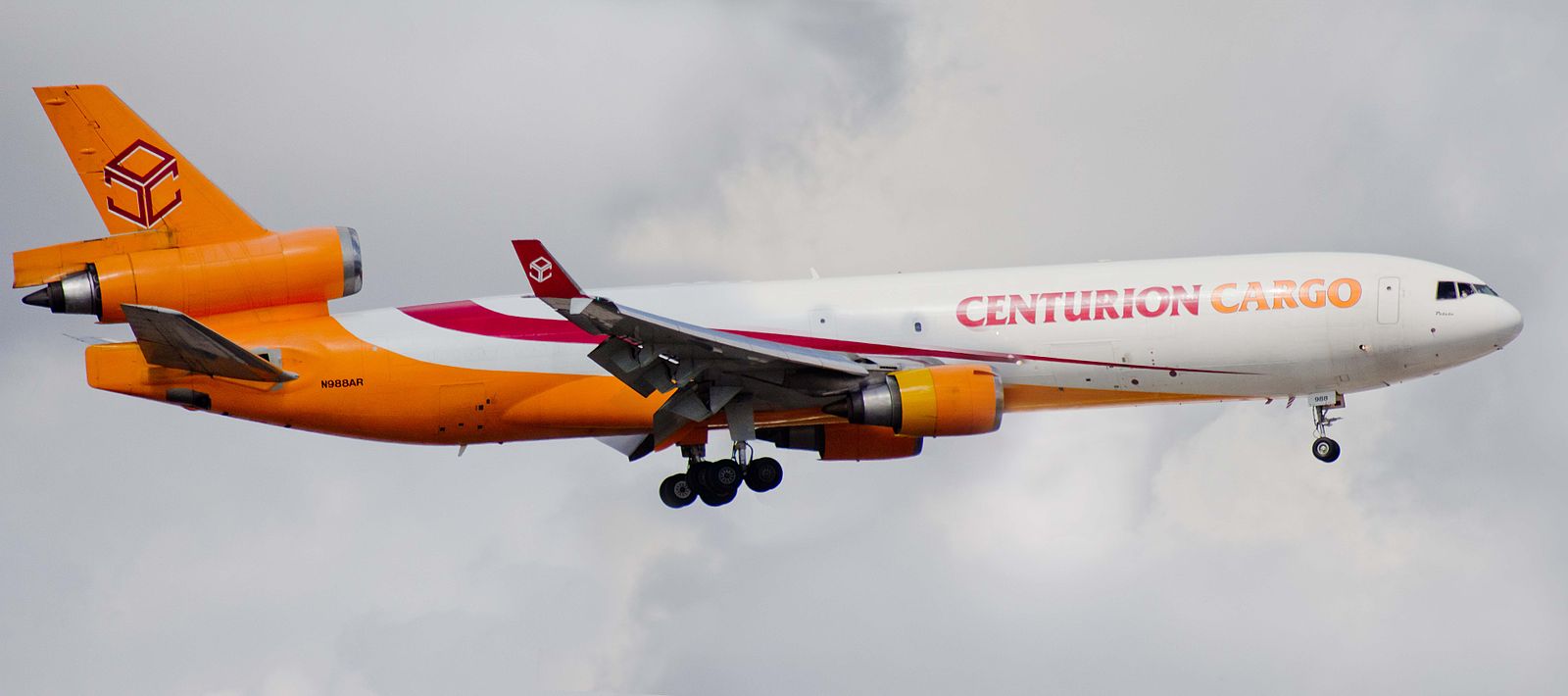Airport with the first officer in the right cockpit seat as ‘Pilot Flying’ (PF). The commander, as ‘Pilot Non-Flying’ (PNF) was in the left cockpit seat and another first officer qualified pilot was seated on the ‘Jump Seat’.
The Centurion Air Cargo MD11 N701GC flight was uneventful and the crew obtained ATIS information ‘F’ prior to descent.
This included the information that the cloud was BKN at 2500 ft amsl and that the QNH was 973 mb.
The crew briefed for an ILS approach to Runway 27 and subsequently they all agreed that the QNH was included in the brief.
Then, once the crew had checked in with ‘East Midlands Approach’ at FL80, the controller advised N701GC that the current ATIS was now information ‘G’; the crew responded that they would check the latest information. The only change from ‘F’ to ‘G’ was that the QNH had increased by 1 mb to 974 mb.
At 23 nm range, the Centurion Air Cargo MD11 N701GC was cleared by ATC to descend to 3,000 ft on the QNH of 974 mb. This clearance was correctly acknowledged by the crew who also requested and were given clearance to intercept the localizer on the aircraft’s current heading.
At about this time, the crew of Centurion Air Cargo MD11 N701GC selected approach mode on the autopilot but the aircraft then started a turn to the left, which was away from the localizer centre-line.
The crew reselected the required heading and then reselected the approach mode. Thereafter, the crew configured the aircraft for landing whilst closely monitoring the heading and localiser indication.
As the Centurion Air Cargo MD11 N701GC descended to a new cleared altitude of 2,000 ft, the handling pilot stated that he had the PAPI in sight. Then, once the crew had reported that the aircraft was established on the ILS, N701GC was transferred to ‘East Midlands Tower’.
When the crew checked in on ‘Tower’ with the information that they were established on the ILS, the controller asked for confirmation of the aircraft’s altitude; the crew responded with 2,000 ft.
ATC then asked the crew to check that 974 mb was set on the altimeter and the crew acknowledged the message. On the flight deck, the three altimeter settings were corrected and the subsequent landing was uneventful.
After landing, the crew discussed the event and then the commander telephoned ATC.
He confirmed to ATC that they had received the correct pressure setting but that they had not set it on the altimeters which were, therefore, still on the standard setting of 1013 mb.
The crew then contacted their company to report the event and completed the appropriate national reporting procedures.
The incident resulted from an omission by the crew to set the QNH on the altimeters even though it was correctly passed by ATC and acknowledged by the crew. Shortly after acknowledging the correct QNH, the crew noticed the aircraft, on autopilot, turning away from the expected heading.
Thereafter, their attention was primarily on monitoring the aircraft’s lateral position and no-one realised that the ‘Descent/ Approach’ checklist had not been completed.
At night and in sight of the PAPIs, it would then have been difficult for any of the crew visually to appreciate that they were much lower than required by the procedure. Furthermore, the two main and the single standby altimeters would have indicated the same altitude and raised no concerns.
The main indication of a discrepancy available to the crew would have been the radar altimeter and it was therefore apparent that the instrument had not been part of any crew member’s ‘scan’.
The radar recording confrmed that the aircraft remained at a level altitude, albeit more than 1,000 ft lower than required, until glideslope intercept. Close monitoring and effective action by the ‘Tower’ controller enabled the true situation to be identified and resolved. Whilst there was no possibility of the incident progressing to an accident, the investigation, by both the company and the AAIB, indicated ways to reduce the probability of a similar incident.
The investigation and action by the operating company were thorough and ensured that all their crews were fully aware of the incident together with the factors involved. The importance of ensuring that appropriate checklists are fully completed has also been re-emphasised together with the need for the radar altimeter to be included in the ‘instrument scan’.
During the investigation, it was noted that there was a discrepancy between the instructions within MATS Part 1 and the information included on the approach charts for some UK airfields. Although this discrepancy was not considered pertinent to the incident involving N701GC, the Directorate of Airspace Policy has been informed.
Download Report


0 Comments